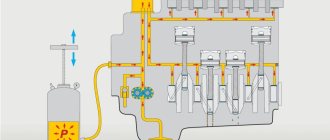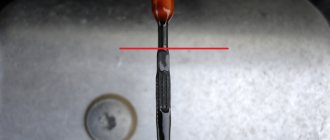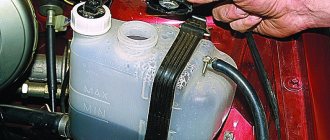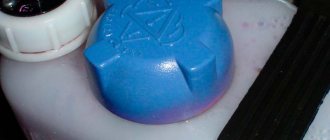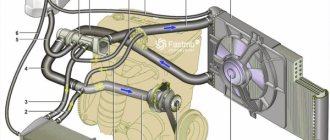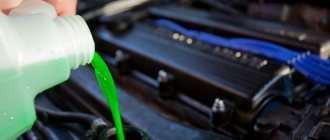| Malfunction (symptom) | Causes | Remedy |
| No oil pressure | Malfunction of the oil pressure indicator. Pump shaft failure. Cut of the pump drive gear mounting pin. Low oil level in the engine crankcase | Replace the oil pressure indicator. Replace the pump shaft. Replace the pin. Add oil to the top mark of the dipstick |
| Low oil pressure | Oil leakage in oil lines. Stuck drain or safety valves. Clogged oil receiver mesh in the pan. The tube supplying oil from the pump to the block is loose or the gasket is damaged. Malfunction of the oil pressure indicator. Low oil viscosity. Worn oil pump parts | Inspect the oil lines and repair any leaks. Wash the valves and remove burrs if necessary. Wash the oil receiver screen. Tighten the bolts or replace the gasket between the tube and the block. Check the pointer and replace it if necessary. Change the oil. Replace worn parts or pump assembly |
| Smoky exhaust (blue smoke) | Oil entering the combustion chamber due to excess oil in the crankcase | Set the oil level to the top mark of the dipstick |
| Insufficient rotation speed of the centrifuge rotor | The rotor nozzle is dirty. Damage to the gasket between the frame and the rotor cover. Rotor axis jamming | Clean the injectors. Replace the gasket. Replace the centrifuge |
| High oil pressure | High oil viscosity. Pressure relief valve stuck. Oil line clogged | Change the oil. Wash and adjust the valve, remove burrs. Clean and flush the oil line |
When the filters become clogged, the bypass valve is activated and the oil enters the system unpurified (bypassing the filters). This leads to rapid wear of engine parts. Therefore, it is necessary to periodically check and, if necessary, replace (or clean) the filter elements. As the pump teeth and walls wear, the oil flow and pressure in the system decreases. Therefore, periodic monitoring of the pump’s performance is necessary by measuring the pressure at the outlet of the pump while the engine is running, as well as by visually checking and measuring the gap between the ends of the gear teeth and the walls of the housing when disassembling the pump.
Failures and malfunctions of the lubrication system
Oil pressure exceeds the permissible value during normal engine operation (in all modes)
Sensor or pointer is faulty
Replace sensor or pointer
Due to oil contamination, the pressure relief valve jammed
Clean the seat and pressure relief valve, adjust the valve
Increased oil pressure when the engine is idling and at average crankshaft speed
System channels are dirty
The oil in the engine is too viscous
Replace the oil with another one in accordance with the manufacturer's recommendations
Low oil pressure with normal oil flow
Low oil level in the system
The pressure reducing valve is worn out or misadjusted; mechanical particles got under the valve
Choosing engine oil for VAZ 2103
What to look for when choosing oil? Correctly changing the oil of a VAZ 2103 engine, or any other engine, means filling in the same type of oil as it was from the same company, preferably. How to choose the right motor oil
How to choose the right motor oil
This is done because the engine is already accustomed to working with this oil and there is less chance of harmful deposits, precipitation and the like. But you can switch to another, say, higher quality oil. So which one should you choose? As for the manufacturer, there are no special rules. It all depends on the desire and price of the oil. If finances allow, it’s better to buy more expensive ones, because more expensive means better quality. And the higher quality the oil, the later it is to overhaul the engine. You can buy oil of domestic brands or foreign ones - but not a cheap fake - it will only make things worse!
There are many companies - choose the bestMineral motor oil
Mineral water from LIQUI-MOLY
So:
- Is mineral oil (simply “mineral water”) suitable for a VAZ 2103? Yes, it will do. After all, this car was manufactured back in Soviet times, and then, perhaps, this was the only oil they used. We went and were happy.
- But “can” does not always mean “necessary”. Yes, it is permissible to use a mineral water engine, but it is not recommended. Why? Time will tell - or rather, time will pass, winter will come, frost will hit and your engine, when you try to start it, will show you, excuse me, nothing!
- Yes, yes, and all because mineral oil has a very bad property - it freezes at low negative temperatures. This is not the only negative property. Mineral water also leaves deposits on engine parts and also requires frequent replacement.
Semi-synthetic
Semi-synthetic 10W-40
So:
- This oil has already improved properties and characteristics in comparison with mineral water. The service life of semi-synthetics is noticeably longer; accordingly, it will better retain its properties until the necessary replacement due to mileage. Less negative impact on the engine than mineral oil.
- The price of such oil is not that high. It is easy to buy in almost any store. In a word, it is a universal oil, which is often used in Zhiguli cars.
Synthetic motor oil
Synthetic motor oil
So:
- This oil is by far the best there is. It has become widespread due to its high performance properties and good ability to maintain the functionality of all engine parts.
- Synthetics also hold up well at low temperatures, which is extremely useful under harsh working conditions.
- But still, synthetic motor oil is not recommended for use in such cars for several reasons. The main one is expediency. The whole point is that the car was developed a very long time ago, when such oils did not yet exist.
- And engine parts can easily run on both mineral water and semi-synthetic. And the price for synthetics is simply astronomical. So there is simply no need to pour such oil when changing the oil in a VAZ 2103.
Lubrication system maintenance
The most common malfunctions of the lubrication system are: decreased oil level, increased or decreased pressure in the system, oil contamination.
A decrease in oil level can be caused by a leaky engine oil sump, a poor crankshaft seal, or worn oil seals and oil burnout.
Increased pressure in the lubrication system can be caused by the use of oil of high viscosity, contamination of the system channels and oil filter, malfunction of the pressure relief valve, in rare cases - failure of the oil pressure sensor, and low pressure - insufficient oil level in the oil sump, a decrease in its viscosity, or clogging of the oil receiver , wear of oil pump parts, crankshaft or camshaft bearings, sticking of the pressure reducing valve in the open position.
The reasons for intensive oil contamination and its rapid aging are the ingress of coolant into the oil, prolonged engine operation in modes different from the nominal ones (coolant temperature less than 60 ° C or more than 100 ° C), significant wear of parts of the cylinder-piston group, and the use of inappropriate oil.
The quality of the lubricant and the lubrication system have a significant impact on the operating efficiency of the equipment. Therefore, any disturbances in the lubricant supply system can lead to improper operation of the mechanism and its rapid wear. To avoid this, it is necessary to carry out regular diagnostics of the equipment and study all possible signs and causes of malfunction of the lubrication system.
Fixing oil leaks in a car
Once you've found the source of the leak in your car, it's time to decide whether you can fix it yourself as soon as possible. For example, even if you don't have much experience in car maintenance and repair, you can fix a valve cover gasket leak quite easily.
Also, in some cases, you will be able to eliminate oil leaks from the oil filter yourself. In other cases, you need some experience in car repair and maintenance, as well as a repair manual for your car model. Especially if the oil starts leaking due to wear of the crankshaft seals. If you have such experience, then if you find oil leaking, contact a technical auto center as soon as possible. True, we still advise you to enter the location of the leak yourself in order to avoid being deceived at the car service center.
Fortunately, as is the rule, oil and other fluid leaks in new or fresh cars are a rare occurrence. However, as the mileage increases and depending on the load on the vehicle during operation, many of its gaskets, seals and oil seals wear out, which can lead to fluid leaks. Gaskets and seals in the engine can wear out especially quickly due to sudden temperature changes.
Therefore, from time to time you should not only simply change the oil, oil filter and air filter, but also conduct a thorough inspection of all the main components of the car. This is the only way you will be able to notice a possible leak of oil and other liquids in time.
Don't be afraid to own your own car. Each of you is able to inspect your car from time to time for fluid leaks. You don't need any skill for this. Your task is to notice the leak in time.
Remember that periodic inspection, as well as timely scheduled maintenance, will help you keep your car in good condition, and also protect you from major breakdowns. This will allow you to save not only your nerves and time in the future, but of course money.
Types of lubrication system malfunctions
Normal operation of the equipment requires constant monitoring of oil temperature, presence of contaminants, water ingress or leakage. There are several types of lubrication system malfunctions, the untimely detection of which can lead to serious problems with the equipment. Among such violations:
- damage or wear of the oil pump;
- clogging of the filter element;
- damage to the pump gasket;
- poor filter fixation;
- failure of the pressure sensor;
- low oil level;
- heating the lubricant;
- pressure relief valve sticking.
The cause of these malfunctions may be the end of the service life of system elements, violation of the rules for working with equipment, or poor quality maintenance. Among the most common types of violations are the use of low-quality lubricant and irregular replacement of the oil or filter element.
Causes of injector clogging
Typically, problems with the injection system occur when using low-quality gasoline. Heavy paraffins contained in such fuel settle on the walls of the system, cutting off the fuel supply. Manufacturers of high-quality gasoline add detergent to it - a special additive that dissolves deposits. Low-quality gasoline contains too much paraffin, which forms deposits faster than detergents can remove them. Deposits form more intensively at low temperatures, so when the car is frequently driven with a cold engine, the injector becomes clogged more often.
Deposits can accumulate not only in the injectors. Often vapors settle on the throttle valve, which leads to a change in the proportions of the air-fuel mixture entering the cylinders.
Deposits of substances contained in low-quality gasoline may also appear on the back of the intake valve plates. This can lead to valve burnout or fuel detonation.
To clean the injection system of deposits, it is necessary to use special flushing fluid and equipment. You can wash the injector in a garage. To do this, you need a syringe and washing liquid. The latter is mixed with gasoline and poured into the injection system through the hose of the vacuum brake booster. First, the operation is performed with the engine turned off, then with the engine running. The mixture is fed into the running engine gradually, in small portions. As a result, the deposits dissolve, enter the engine cylinders and burn there. In this case, clouds of smoke may briefly appear coming out of the muffler.
The power unit of the injection VAZ 2107 was the first at AvtoVAZ in a number of injection models. Therefore, the new product raised many questions and comments: Soviet drivers did not know how to maintain and repair such an engine. However, practice has shown that the injection equipment of the “Seven” is very practical and convenient, and also allows for a number of alterations and modifications for the driver himself.
Signs of lubrication system malfunctions
External signs of lubrication system malfunctions are increased material consumption, oil contamination, increased or decreased system pressure and heating of the lubricant in friction units.
Low system pressure may indicate insufficient oil, a leak, worn pump parts, or a stuck pressure relief valve. Increased pressure may indicate excessive viscosity of the lubricant used or clogged oil lines.
The quality of lubrication is also affected by increased material temperatures in oil systems. The cause of such a violation may be excessive heat generation that occurs during friction of parts. Therefore, it is necessary to carefully monitor the temperature conditions of the lubrication system. As bearing temperatures rise, check the oil filters and valves for clogging, and make sure there are no oil leaks or oil pump problems.
Does oil even drip from under your car?
If you regularly find drops or even puddles of viscous oily liquid under your car, you first need to make sure that the problem is really with the oil. Perhaps this is simply water that has accumulated during the trip, which washes away many years of dirt and drains when the car is at rest. There are other options for the formation of unpleasant puddles during the operation and storage of a car. It is worth doing the following checks:
- take a sheet of white paper, use a cotton swab to collect liquid from the puddle and anoint the paper, look at the result and wait a few seconds to be sure;
- if you have oil in front of you, the paper will become more transparent in the place where you smeared it with liquid, and a greasy stain will also be visible that does not go away for a long period of time;
- if the spot is just wet, then you are dealing with another liquid, it could just be water from the washer reservoir or rainwater that has collected in certain grooves;
- if the paper begins to turn green, red or blue, it is worth checking the cooling system; most likely, the leak is coming from there, and there is antifreeze on the garage floor;
- With a constant frequency of liquid appearing on the floor where the car is stored, it is still necessary to carry out a full-fledged high-quality diagnosis and solve all the problems.
Do not use barbaric verification methods, which are written about so much on the Internet today. Spare your car and take it to a mechanic. You can simply show the car to an experienced person who knows more than you in technical aspects and can really help you complete all the tasks efficiently and in a short time. All this will really help to find the problem and fix it in order to get rid of unpleasant and alarming stains.




